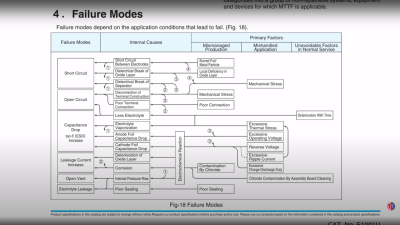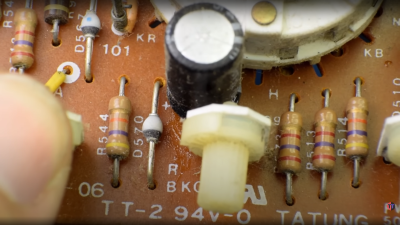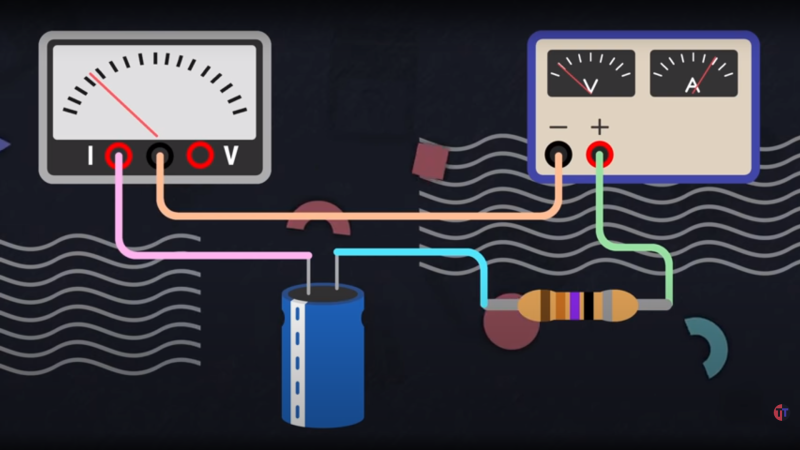Having acquired some piece of old electronic equipment, be it a computer, radio, or some test gear, the temptation is there to plug it in as soon as you’ve lugged it into the ‘shop. Don’t be so hasty. Those power supplies and analog circuits often have a number of old aluminium electrolytic capacitors of unknown condition, and bad things can happen if they suddenly get powered back up again. After a visual inspection, to remove and replace any with obvious signs of leakage and corrosion, those remaining may still not be up to their job, with the oxide layers damaged over time when sat idle, they can exhibit lower than spec capacitance, voltage rating or even be a dead short circuit. [TechTangents] presents for us a guide to detecting and reforming these suspect capacitors to hopefully bring them, safely, back to service once more.

When manufactured, the capacitors are slowly brought up to operating voltage, before final encapsulation, which allows the thin oxide layer to form on the anode contact plate, this is an electrically driven chemical process whereby a portion of the electrolyte is decomposed to provide the needed oxygen ions. When operating normally, with a DC bias applied to the plates, this oxidation process — referred to as ‘self-healing’ — continues slowly, maintaining the integrity of the oxide film, and slowly consuming the electrolyte, which will eventually run dry and be unable to sustain the insulating oxide layer.
If left to sit un-powered for too long, the anodic oxide layer will decay, resulting in reduced operating voltage. When powered up, the reforming process will restart, but this will be in an uncontrolled environment, resulting in a lot of excess heat and gases being vented. It all depends on how thin the oxide layer got and if holes have started to form. That is, if there is any electrolyte left to react – it may already be far too late to rescue.
If the oxide layer is sufficiently depleted, the capacitor will start to conduct, with a resultant self-heating and runaway thermal decomposition. They can explode violently, which is why there are score marks at the top of the can to act as a weak point, where the contents can burst through. A bit like that ‘egg’ scene in Aliens!

The ‘safe’ way to reform old capacitors is to physically remove them from the equipment, and apply a low, controlled voltage below the rated value to keep the bias current at a low value, perhaps just 2 mA. Slowly, the voltage can be increased to push the current back up to the initial forming level, so long as the current doesn’t go too high, and the temperature is within sensible bounds. The process ends when the applied voltage is at the rated value and the current has dropped off to low leakage values.
A word of warning though, as the ESR of the reformed caps could be a little higher than design, which will result in higher operating temperature and potentially increased ripple current in power supply applications.
We’re really glossing over this subject fast here, but [TechTangents] was kind enough to link to some fine capacitor-related reading for those who need a primer. Here is a US DoD handbook for reforming capacitors with advice on storage shelf life, some tech notes on using electrolytic capactors from chemi-con, and a general capacitor guide from TDK. Reforming caps is nothing new, here’s an previous article about repairs, and something a bit more recent.
Thanks [Jimi] for the tip!

















well…
to save your milliamp meter, i suggest taking it out of the loop altogether and just measure the voltage across the resistor. so in case your capacitor develops a short, it will not hurt your meter.
If you go through the trouble of removing the capacitors from PCB, seems like you might just replace them..
This exactly! Also if you want to retain vintage looks re stuff the capacitors with modern ones… do not reform. If you want a machine to operate correctly you have to replace the consumables and that is what capacitors are when it comes to vintage computers and electronics.
Would you clean out an oil filter in a car and reuse it with 50k miles on it?
Have you priced these recently? I spent $150 ten years ago shotgunning caps on two linears in old computing equipment. It adds up.
Depends on the use case and the age… if its early 90s or older its time. Old tantalums will outright explode randomly also.
You can revive older stuff and it hold together in audio equipment but it won’t sound like it did new… instead you get the “old equipment sound” some people have a false nostalgia for.
Caps are cheap unless you’re talking about the soup can size. Those typically do reform quickly and quite well. I limit the supply current to maybe a few hundred ma and slowly crank up to the specified voltage. They almost always settle at less than 1ma in 5-10 minutes. Longest I ever had to let some go was 45 minutes. That was a pair from an old Data General Nova.
Axial caps are getting expensive but I don’t have a problem using radials as a replacement if there is board space.
Have you priced replacing the power transformer after a capacitor shorts after some bozo listens to another idiot talk about reforming a capacitor?
I assure you, it’s more.
i consider capacitors of a certain age to be desirable. relics from before the capacitor plague that were dealt a good hand by survivorship bias. i only recap stuff from the plague era, usually with stuff salvaged from older equipment.
Holy run-on sentences batman!
Merriam-Webster defines a run-on sentence as “containing two or more clauses not connected by the correct conjunction or punctuation”. I’d say that only the last two sentences run on; others are merely long and perhaps a bit awkward.
I think those last two sentences represent a relatively recent phenomenon. A hyperlink contains information which isn’t a direct part of the sentence which contains it; this often results in unconventional sentence structures.
The word “Here” at the beginning of the second-last sentence is a good example. It would normally require a colon, followed by the things which “Here” refers to, somewhere later in the sentence. In this case the hyperlink makes the word alone sufficient; but in the absence of an internet connection the sentence is incomplete.
Who knew that a computer with an internet connection would someday become a grammatical element? ;-)
I don’t know what you’re talking about, there are no problems with the text as faf as I was able to gather, except maybe the last sentence where the “an” should have been an “a”.
Well, I bought a variac to reform the electrolytic caps in my old tube reel to reel. You won’t change a capacitor in a tube amplifier, since the amp is not only an electric device, but also an “musical instrument”. Changing the capacitors will change the sound as well. Old vintage amp sound as they sound because caps have higher ESR and less capacity, maybe.
A lot of what people thing and has been digitized as “old amp sound” is just bad caps… and they never sounded that way new.
“You won’t change a capacitor in a tube amplifier, since the amp is not only an electric device, but also an “musical instrument”. Changing the capacitors will change the sound as well.”
Maybe you won’t, but leaving a dying cap in the signal chain will also change the sound… to crap.
Leaving a dying electrolytic cap in the power supply can “change the sound” too… to silence, once you’ve burned up a usually irreplaceable power transformer.
Why is this not a reply?
Nested replies sometimes don’t work here – I think it has something to do with WordPress limitations. There have been times when I haven’t posted a comment because there was no “Reply” link at the bottom of comment I wanted to respond to.
Methinks a major overhaul of the Hackaday site is loooooong overdue…
Slashcode!
The Japanese capacitors have the longest life I remember when I worked in computer industry Aztec power supplied used in everything from bbc computer to vid terminals had a japanese 220 mfd capacitor next to a heatsink which used to fail a lot ibm power supplied used in their larger computers had a lot of black roederstein electrolytics that used to go open circuit I
Bm put rivets in their cases you had to drill out capacitor last a long time if kept cool apart from rubbish makes like callins which tv and audio used in 1970s vintage tv and audio made by thorn when thorn used ruby on electrolytics in the 1980s they were better I put a bulb in series when restoring old radios the value of am valve radios must have dropped now am transmitters are switching off
CAP reforming is a joke!
Well, don’t keep us in suspense, what’s the punch line?
The most common failure mode for old electrolytic capacitors is they dry out. No amount of “reforming” will make a dry cap come back to life. He’s dead Jim.
Actually I sort of remember a process where you poked a hole and added a liquid for 1920 electrolytics
Reforming electrolytic caps is a myth and complete nonsense, because the “dry” type (the usual for about a century now) is missing the chemistry to regenerate the oxide layer. Reforming only plugs holes in the oxide with gas bubbles, which won’t last long. And there’s another problem that cannot be repaired: Chlorine contamination of the electrolyte. That was fixed somewhere in the 1980s.
In a nutshell, bad electrolytics should always be replaced with fresh ones (they also have a limited shelf life).
So at what age should we start worrying about this? I haven’t powered up my old 1980’s IBM Luggable in at least a decade, possibly two; I’m not enthusiastic about re-capping it but I do believe museum pieces ought to be kept operable if they’re to be kept at all.
I don’t especially like the idea of gutting it and putting modern electronics into the case, though if the alternative was throwing it out…
Then that is a prime candidate. Check carefully.
Reforming capacitors is something that morons that read articles on the internet, written by other morons, whom have zero idea how modern capacitors are made.
Period.
Reforming capacitors is a myth.
I think the article is about reforming old capacitors made the old fashioned way. The article gives good information that the technique works at least for a short time, maybe it works for a long time, either way measurements are needed – not opinions.